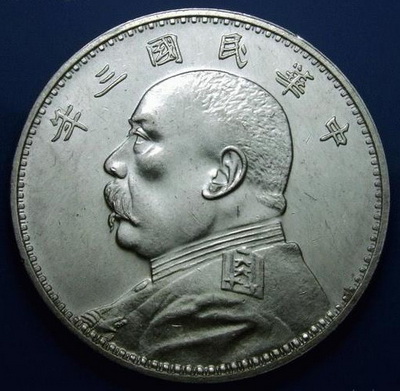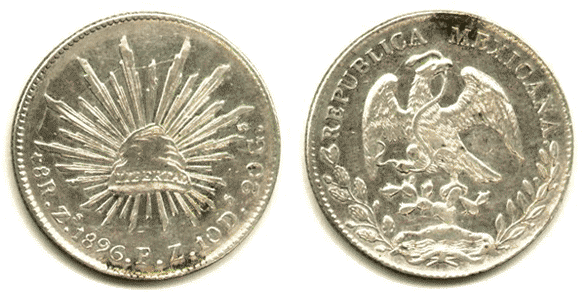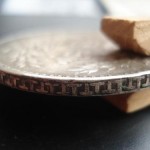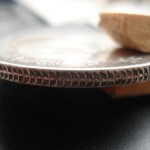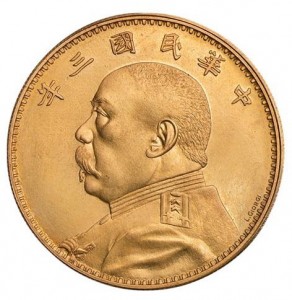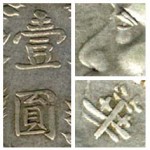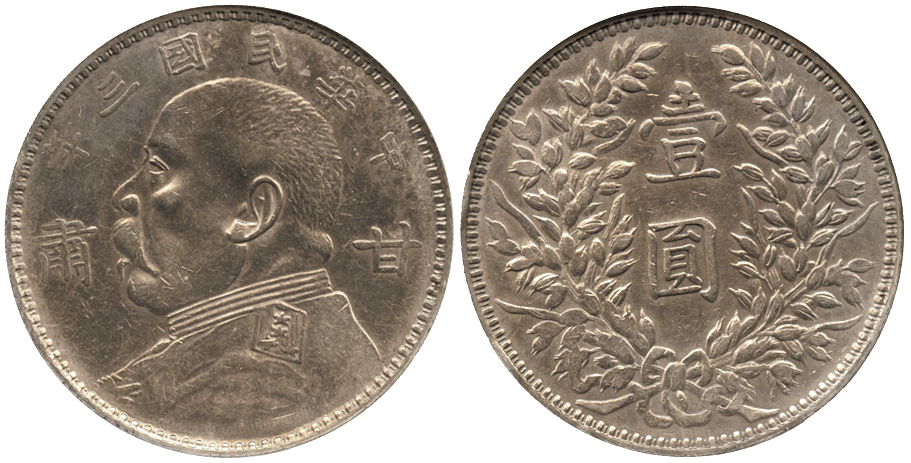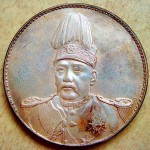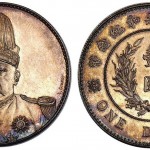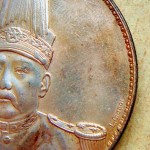The Yuan Shi Kai silver dollar coin is one of the most commonly found Chinese silver dollar around the world, but paradoxically, there is few accurate information available about in English. Called 袁大头 in China (literaly “Yuan [Shi Kai] big head”), and “Fatman dollar” in the United States, this coin was designed to put an end to the chaotic state of the Chinese monetary system and further the political agenda of Yuan Shi Kai, who had just taken over the function of President of the newly born Republic of China.
Introduced for Christmas 1914, the Yuan Shi Kai silver dollar had a standardized purity (0.89000 silver) and weight (26.4000g, .7555 oz ASW). Like the previous central imperial issues, this new currency would have to compete against the chinese silver dollars already in circulation, foreign trade dollars, and resistance from provinces using primarily copper currency or paper money. The introduction of the Yuan Shi Kai dollar coincided with the withdrawal and melting of about 280 million dragon dollars. The remaining dragon dollars, whose fineness was not always up to the standard, could be exchanged free of charge for the new Yuan Shi Kai dollar in all Bank of China, Bank of Communications branches or official provincial banks.
These political measures helped the new currency to gain traction, but at the beginning of World War I, the Mexican dollar was still trading at a premium against chinese dollars, due to its use as a means of payment for exports. It is only after the War caused exports to plummet than the Yuan Shi Kai dollar was able to replace the Mexican dollar. The loss of the export markets also undermined the faith in the interprovincial paper money, which relied on external demand for local products, and caused the collapse of local copper currencies.
These economical factors contributed to the outstanding success of the Yuan Shi Kai dollar, which gradually penetrated even the most remote provinces of China. In 1924, a survey conducted by the Shanghai Bank found that of the estimated 960 million silver dollar in circulation in China, about 750 million were Yuan Shi Kai dollars.
Like the imperial dragon dollars before it, the Yuan Shi Kai dollar was minted in the Central Mint in Tianjin, and provincial mints were given official sets of dies. Due to its success, the “Fatman dollar” was minted during a longer time than any of its predecessor, and in much greater quantity, so the worn out dies eventually had to be retouched or re-engraved. This lead to a lot of dies varieties, some of which became very popular amongst coin collectors.
Scarce Die Variations: the 1914 Yuan Shi Kai Dollar (3rd Year of the Republic of China)
The 1914 Yuan Shih Kai dollar can be easily identified, even if you can not read Chinese, because it has only six characters on the obverse. All subsequent strikes have seven, due to the addition of the character “造” (made). This series offers some of the most interesting die differences.
The Central Mint in Tientsin issued some early pattern coins as a trial. Some of these coins have an ornamented edge, with a “T” like pattern (T字边), other have an edge similar to the one of the then popular Mexican dollar that this new currency sought to replace (鹰洋边, “Western Eagle” edge). These coins are the scarcest and most expensive.
Some of these trial coins also feature the signature of the italian engraver, L. Giorgi, who designed the coin. Most of the other die variations have been produced by provincial mints, and can usually be identified by looking at some details of the Yuan Shi Kai portrait. The design of the eyes and the 華 character (second starting from the right) are very different on the Kansu Mint die.
The coins issued by the Gansu Mint have a lower silver content than other Yuan Shi Kai dollar. They therefore circulated at a discount at the time, but ironically they are now more expensive than regular dollars due to their relative scarcity. The Gansu Mint also produced some coins with a custom die featuring the province name, which were quickly withdrawn by the government. This is now one of the most expensive versions of the Yuan Shi Kai dollar.
There is many more popular types amongst collectors, like the “O” die (O版), the “O die with triangular yuan character” (O版三角圆), or the “long leaves” dollar, all of which will be the object of another post…
I recently found a beautiful, slightly toned Yuan Shi Kai republican dollar while hunting for rare chinese coins. Looking more closely, one can see the signature of the engraver L. Giorgi on the coin. Specimen with signatures are very rare, and such a coin is easily worth between $4000 and $8000 USD.
Here is the coin:
It looks great, but I soon started to have doubts about its authenticity when I got it out of its protective case: the reeded edge felt a bit too rough and shallow. Knowing that this pattern coin is very rare, I also knew the odds I found a forgery were pretty high. I therefore looked closely at the portrait and a picture of a real coin sold in a reputable auction to find if there was some visible differences.
Here is a genuine Yuan Shi Kai commemorative dollar (Kann 642a), can you spot the difference?
If you look closely at the signature of the engraver “L. Giorgi” on both coins, you will find that it is very well imitated, but slightly off on the fake coin. On the real one, the signature is over the 5th bead on the edge, while on the fake, it is over the 4th bead. See below:
Aside of this detail, the forgery was very convincing. The portrait did not show any significant difference. After a bit more research, I also found that the engraver’s signature on a contemporary Yuan Shi Kai pattern coin, the so-called 飞龙, is actually over the 4th bead. Could this coin be a mule, or a die variation?
After finding this out, I went to the Madian coin market to seek the advice of a professional coin dealer. At the first sight, he thought the coin was real. When I wanted to sell it, he went to show it to a colleague and then came back, saying it was fake. Interestingly enough, it was not the signature position that raised a red flag to them, but the relief of the coin. The real one is totally flat around the Yuan Shi Kai portrait, while on mine both sides of the portrait are not exactly of the same depth. This can only be seen by slowly inclining the coin in front of a light source.
